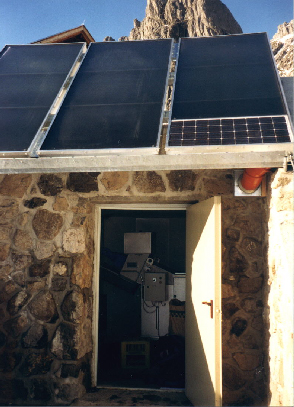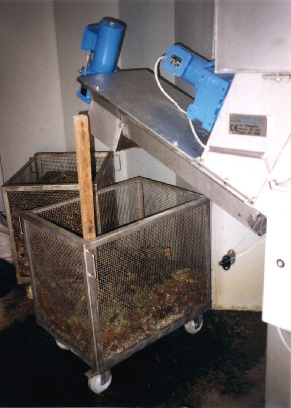environmental benefit of wastewater treatment plants in mountainous areas in the alps

|
Comparison of technology, costs and environmental benefit of wastewater treatment plants in mountainous areas in the alps |

|
Site description and boundary conditions
Design and treatment efficiency
maximum daily organic load [PE]
84 maximum hydraulic load [m3/d]
5.1
annual organic load [kg BOD/a]
140
altitude [m a.s.l.]
2129
sensitivity [hydrogeology, protected area ...] limestone
lagal requirements [BOD elimination]
80 %
operation period [season]
summer
energy supply [type, kW]
photovoltaic, aggregate
means of transport [type]
supply cable car
existing WWTP [type, condition, volume l/PE]
no facilities

Fig. 4.17: Flow-scheme of the WWTP Hermann von Barth Refuge

Fig. 4.18: Building with the mechanical solids separator and the solar collector for the hot-air heating of the composting room.

Fig. 4.19: Feed screw and dosage equipment (compost aid like saw dust) of the mechanical solids separator and 2 compostainers.
Loading of biological treatme
WWTP Hermann von Barth Refuge saisonal average max. week max. day loading [PE60] 22 6.5 84 BOD5-loadt [kg/d] 1.33 3.9 5.04 influent flow Q [m3/d] .14 4.1 5.1
Design according to the F/M ratio in the max. week
Two compost toiletts with about 500 kg compost each
Energy demand
max. power [W] max. electric work [kWh/d] mean electric work [kWh/d] 280 0.14 0.08
Treatment efficiency
date
[dd.mm.yyyy]
dry matter
[weight %]organic content
[weight %]temperature
[°C]loading
[% of PEmax ]05.09.1999 49 90.7 15 -- 09.-10.09.2000 19.6 91 14 161 23.09.2001 22.4 88 31 75